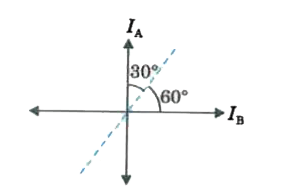Two beams, A and B, of plane polarised light with mutually perpendicular planes of polarisation are seen through a polarised light with mutually perpendicular planes of polarisation are seen through a polaroid. From the position when the beam A has maximum intensity (and beam B has zero intensity). a rotation of Polaroid through 30∘ makes the two beams appear equally bright. If the intiial intensities of the two beams are IAandIB respectively, then IA/IB equals :
1/3
3
3/2
1
The correct Answer is:A

IA=cos230∘=IBcos260∘
IA(√32)2=IB(12)2
IA(34)=IB(14)
IAIB=13
Topper's Solved these Questions
- WAVE OPTICALBOOK - MODERN PUBLICATIONCHAPTER - WAVE OPTICALEXERCISE - OBJECTIVE TYPE QUESTIONS (JEE (ADVANCED) FOR IIT ENTRANCE)
6 Videos
- WAVE OPTICALBOOK - MODERN PUBLICATIONCHAPTER - WAVE OPTICALEXERCISE - OBJECTIVE TYPE QUESTIONS (C. MULTIPLE CHOICE QUESTIONS)
14 Videos
- WAVE OPTICALBOOK - MODERN PUBLICATIONCHAPTER - WAVE OPTICALEXERCISE - OBJECTIVE TYPE QUESTIONS (B. MULTIPLE CHOICE QUESTIONS) -AIPMT/NEET & OTHER STATE BOARDS FOR MEDICAL ENTRANCE
10 Videos
- SEMICONDUCTOR ELECTRONICS METERIALS DEVICES AND SIMPLE CIRCUITS BOOK - MODERN PUBLICATIONCHAPTER - SEMICONDUCTOR ELECTRONICS METERIALS DEVICES AND SIMPLE CIRCUITS EXERCISE - CHAPTER PRACTICE TEST FOR BOARD EXAMINATION
12 Videos
Similar Questions
Two beams A and B, of plane polarized light with mutually perpendicular planes of polarization are seen through a polaroid. From the position when the beam a has maximum intensity (and beam B has zero ntensity), a rotation of polaroid through 30∘ makes the two beams appear equally bright. If the initial intensities of the two beams are IA and IB respectively, then IAIB equals:
View SolutionWhat is a polaroid ? How is plane polarised light obtained with its help ? Mention two devices which use polarised light.
View Solution
Knowledge Check
Two beams A and B, of plane polarized light with mutually perpendicular planes of polarization are seen through a polaroid. From the position when the beam a has maximum intensity (and beam B has zero ntensity), a rotation of polaroid through 30∘ makes the two beams appear equally bright. If the initial intensities of the two beams are IA and IB respectively, then IAIB equals:
A3B32C1D13Two beams A and B, of plane polarized light with mutually perpedicular planes of polarization are seen through a polaroid. From the position where the beam A has maximum intensity and the other beam B has zero intensity , the polaroid is rotated through 30∘ making the two beams appear equally bright. If the initial intensities of the two beams are IA and IB0 respectively, then IAIB equals
A2B3/2C1D1/3As polaroid examines two adjacent plane polarised beam A and B whose planes of polarisation are mutually perpendicular. In the first position of the analyser, beam B shows zero intensity. From this position a rotation 30∘ shows that thebeams have same intensity. The ratio of intensity of the two beam IZ&IB
A1:3B3:1C√3:1D1:√3
how can one distinguish between an unpolarised light beam and a linearly polarised light beam using a polaroid ?
View SolutionPlane polarised light is passed through a polaroid. On viewing through the polaroid we find that when the polaroid is given one complete rotation about the direction of light
View SolutionA partially plane polarised beam of light is passes thorugh a polaroid. Show graphically the variation of transmitted light with angle of rotation of polaroid.
View SolutionPlane of vibration and plane of polarisation of a beam of light
View SolutionPlane polarised light is passed through a polaroid. On viewing through the polaroid we find that when the polaroid is given one complete rotation about the direction of light
View Solution
